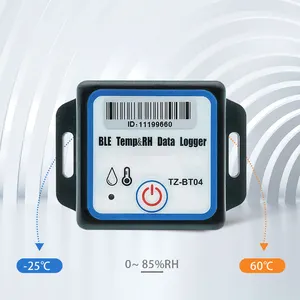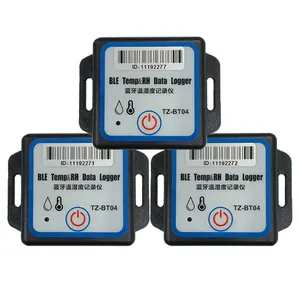
All categories
Featured selections
Trade Assurance
Buyer Central
Help Center
Get the app
Become a supplier

(5676 products available)























































Digital temperature and humidity loggers serve mostly as crucial devices because they track and store temperature and humidity readings over time. They are now available in different shapes, each tailored for special settings and demands. The kinds include:
Basic Data Loggers
These have limited functionality, where it is necessary to measure and record only temperature or humidity. The loggers can store up to thousands of data and may be uploaded for analysis via a computer. Suitable for a few applications where sophistication is not required. Basic data loggers are easy to use and inexpensive, making them a good option for initial uses.
Multi-Channel Data Loggers
These excessive loggers monitor many temperature and humidity sources concurrently. They are indispensable in settings like warehouses and labs, where different areas must be consistently stored, monitored, and recorded. Flexibility is in its design to accommodate more sensors, allowing for complex tracking systems.
Wireless Data Loggers
Real-time transmitting of data to computers or smartphones is via temperature and humidity loggers that are wireless. This removes the need to manually collect the device since the info can be accessed instantaneously. Wireless loggers are perfect for places that are hard to reach or where constant monitoring is vital.
USB Data Loggers
A cheap way to directly transfer recorded data to computers for analysis is using USB data loggers. It is better for those who want hardware with a simple means of data transfer. However, their dependence on a computer for data visualization poses a problem when analysis is necessary in real time. It is still perfect for users who need efficiency.
High-Accuracy Data Loggers
If there's a need for precision logging of temperature and humidity in critical environments, such as pharmaceuticals, laboratories, or food storage. Equipped with advanced sensors to guarantee premium quality data. These loggers may be more expensive but essential in regulated environments where small variations have serious consequences.
However, the key features and functions of temperature humidity data loggers include:
Temperature and Humidity Monitoring
Real-time monitoring of temperature and humidity is done by the logging device, with some logging devices capable of measuring the temperature within the range of -20 to 60 °C and humidity, from 0 to 100%. Internal sensors record the readings of the environment and store them for later analysis. Data accuracy is vital for compliance with industry standards or preservation of sensitive products.
Data Storage Capacity
A logging device may store several thousand readings, enabling prolonged recording without the need to free up memory. For example, the ability to store up to 16000 records is good for conditions where logging occurs over long periods without data access. The larger capacity ensures that no critical data is lost and can capture trends over time for thorough analysis.
Battery Life
Superior humidity loggers feature extended battery lives of up to 24 months, ensuring reliable performance over time without frequent battery replacements. This means constantly recording in inaccessible areas. This becomes crucial during long-term monitoring, especially if the client has not planned to have a battery change.
Data Exporting
Analysis can be done through user-friendly software that accompanies loggers, which lets users view, export, and visualize recorded data. Data can be exported in formats like CSV for easy use in spreadsheets. This feature is also very convenient for users who require detailed reports because the fast and efficient way of accessing historical data is vital for immediate decision-making.
Mobile App Connectivity
Some advanced loggers have mobile app connectivity for real-time data access and alerts. This is where the user gets access to data from a mobile device rather than going to the physical data logger device. Apps generally allow users to set thresholds and receive push notifications whenever readings move out of range, which helps correlate instant access to critical data and prompt responses in managing environmental conditions.
Temperature and humidity loggers are therefore vital instruments in a vast majority of industries. Their ability to monitor environmental conditions makes them very useful for various applications. Below are a few common scenarios when these devices are deployed:
Pharmaceutical Industry
Pharmaceuticals, sensitive drugs, and vaccines are stored in warehouses. The temperature and humidity conditions greatly affect the efficacy and shelf life of these products. Here, loggers are used to ensure that storage environments meet specified criteria. This continuous monitoring helps users document compliance with legal regulations and, most importantly, avoid costly product wastage.
Food Storage and Transportation
In the food industry, proper control of temperature and humidity is necessary for the preservation of quality and safety. Temperature and humidity loggers are used in storage facilities, delivery vehicles, and even during the processing of food items to ensure the right environment is kept. The recorded data helps the user to be proactive in ensuring the food is safe and eliminates possible future problems.
Historic Archive Preservation
Fragile historical books, manuscripts, and artifacts are contained in archives and museums. Situating a temperature and humidity logger in these archives will help keep a record of the ideal storage conditions for the preservation of these items. We prevent deterioration of the valuable collection by providing alert systems that inform when conditions fall out of range. This is important for cultural heritage and for several institutions.
Greenhouses and Agriculture
Loggers are heavily relied on in agriculture for maintaining ideal conditions for plant growth. In greenhouses, for instance, humidity and temperature loggers will help ensure stable conditions for the growth of plants. The data recorded allows farmers to optimize their growing environments. This leads to increased yield and reduces diseases.
Shipping and Receiving
Recorders are vital during transit of products where environmental conditions can affect product integrity. Temperature and humidity recorders can be placed in transit containers and vehicles to safeguard that such conditions are maintained. A record of the shipping environment is made available to the user, and any deviation can be addressed.
Selecting a logger is highly dependent on specific purposes intended, and due consideration ought to be given to the following factors. Below are a few key considerations when choosing an appropriate temperature-humidity data logger:
Accuracy and Range
The required accuracy and range of the temperature and humidity data logger depend on the user's needs. It is crucial to establish whether the user will need very precise measurements since basic loggers will suffice for simple storage, for example, with accuracy within ± 0.5 °C, while pharmaceutical storage may require highly accurate loggers with an extended range. Select a logger with temperature endurance capability from -40 to 70 °C for broader environmental applications.
Data Retrieval
Convenient data retrieval requires consciousness about how the data is to be retrieved. USB loggers are generally convenient since data can easily be retrieved off the device without specialized software. If real-time data is more critical, a wireless model may be the best option. Ensure data storage capacity will fulfill the needs of the client so that the data log remains undisturbed during operations.
Battery Life
The battery life of humidity loggers can range from a few months to more than a year, highly depending on the model and the frequency of measurements. Longer battery life ensures continued operation with less need for manual interventions, particularly in hard-to-reach areas. This uninterrupted monitoring is very important in industries where logging cannot be interrupted.
Environmental Conditions
Consider the environment where the humidity and temperature data loggers will be deployed. The devices are capable of protecting themselves from dust or are exposed to moisture; thus, select a humidity logger with IP protection level. In industrial areas, for example, may need robust loggers to survive extreme temperatures. In adverse conditions, select a logger designed for those conditions.
Software Capabilities
Accompanying software is critical in this analysis because of recorded data. Examine the capabilities such as data visualization, exporting options, and reporting features. The needs of the user might need to be matched with the software functionalities so that efficiency in data management is achieved, especially for users in industries like pharmaceuticals or food that require time-stamped data for reports.
A1: Wired loggers store data continuously until the cable is disconnected. In contrast, wireless loggers transmit data in real-time, offering live monitoring and alerts without physical retrieval.
A2: The loggers have an accuracy of ±0.5°C for temperature and ±3% for humidity in industrial-grade applications. For sensitive uses, high-accuracy loggers are needed to ensure premium quality data records.
A3: Many loggers support user-friendly software and spreadsheet applications for data visualization and report generation. Depending the choices of the user, one might select software that addresses their unique working needs.
A4: Battery life varies based on logging frequency, typically lasting several months to a year. Longer battery life loggers reduce the need for manual intervention, benefiting long-term monitoring tasks.
A5: Many loggers are designed to withstand harsh conditions such as extreme temperatures, humidity, dust, and shocks. Selecting one is appropriate for special requirements of operating conditions.